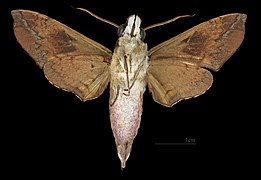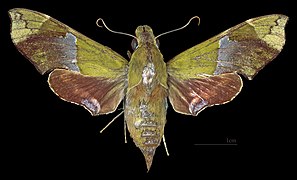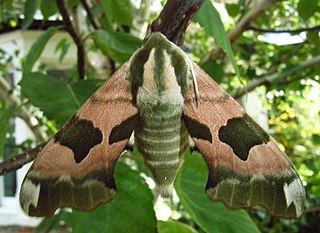
Mimas tiliae, the lime hawk-moth, is a moth of the family Sphingidae. It is found throughout the Palearctic region and the Near East, and has also been identified in Canada's east and western provinces and in northern Spain (Europe). The species was first described by Carl Linnaeus in his 1758 10th edition of Systema Naturae.

Sphinx chersis, the great ash sphinx or northern ash sphinx, is a moth that belongs to the family Sphingidae.

Lintneria eremitus, the hermit sphinx, is a moth of the family Sphingidae. The species was first described by Jacob Hübner in 1823. It is found in the temperate areas of the eastern United States, north into southern Canada over the Great Plains. It prefers gardens and yards, but is common wherever the nectar and larval host plants are found. This moth is easily confused with the Canadian sphinx but these two moths do not typically co-occur.
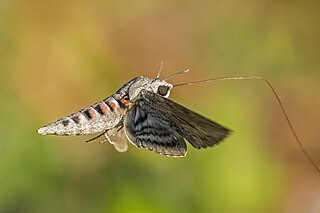
Agrius convolvuli, the convolvulus hawk-moth, is a large hawk-moth. It is common throughout Europe, Asia, Africa, Australia and New Zealand, partly as a migrant. In New Zealand, it is also known as the kumara moth, and in the Māori language as hīhue.
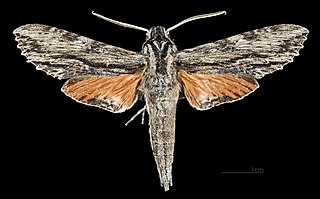
Erinnyis obscura, the obscure sphinx, is a moth of the family Sphingidae. The species was first described by Johann Christian Fabricius in 1775.
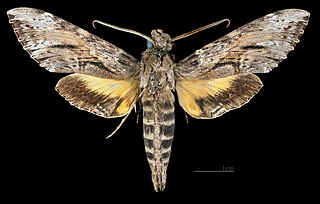
Isognathus rimosa, the rimosus sphinx, is a moth of the family Sphingidae. The species was first described by Augustus Radcliffe Grote in 1865.

Psilogramma increta, the plain grey hawkmoth, is a moth of the family Sphingidae.
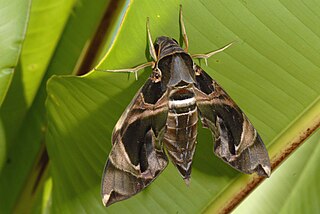
Daphnis hypothous, the jade hawkmoth, is a moth of the family Sphingidae described by Pieter Cramer in 1780. It is known from Sri Lanka, southern and northern India, Nepal, Myanmar, southern China, Taiwan, Thailand, Malaysia, and Indonesia. It is a rare vagrant to the Western Palaearctic realm. During the last hundred years a number have been discovered within the Middle East and one was even found in Scotland late in the 20th century but this was probably imported as a pupa with cargo.

Hemaris tityus, the narrow-bordered bee hawk-moth, is a moth of the family Sphingidae which is native to the Palearctic.

Hyles hippophaes, the seathorn hawk-moth, is a species of moth in the family Sphingidae. The species was first described by Eugenius Johann Christoph Esper in 1789.

The willowherb hawkmoth is a moth in the family Sphingidae. The species was first described by Peter Simon Pallas in 1772.
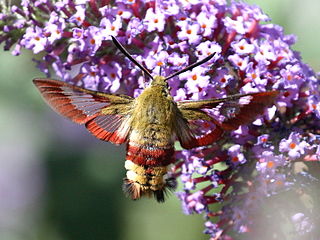
Hemaris fuciformis, known as the broad-bordered bee hawk-moth, is a moth of the family Sphingidae.

Hippotion velox, the dark striated hawkmoth, is a species of sphingid moth or the family Sphingidae. The species was described by Johan Christian Fabricius in 1793.

Acosmerycoides is a monotypic moth genus in the family Sphingidae described by Rudolf Mell in 1922. Its only species, Acosmerycoides harterti or Hartert's hawkmoth, was described by Walter Rothschild in 1895.

Acosmeryx sericeus is a moth of the family Sphingidae. It was described by Francis Walker in 1856.
Angonyx krishna, the southern dark-green hawkmoth, is a moth of the family Sphingidae. The species was first described by Ulf Eitschberger and Jean Haxaire in 2006. It is found in southern India and Sri Lanka.
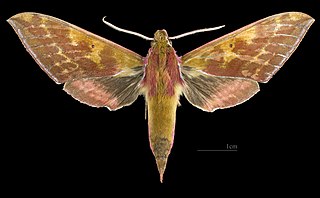
Rhagastis gloriosa, the crimson mottled hawkmoth, is a moth of the family Sphingidae.

Cechetra minor, the lesser green hawkmoth, is a moth of the family Sphingidae.

Meganoton rubescens, the rosy double-bristled hawkmoth, is a moth of the family Sphingidae. It is known from north-eastern India, central and northern Thailand, southern China, northern Vietnam, Malaysia, Indonesia, the Philippines, Papua New Guinea, northern Australia and the Solomon Islands.
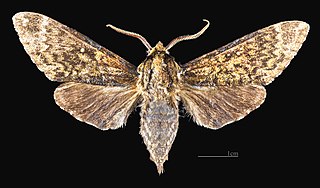
Dolbina exacta, the exact grizzled hawkmoth, is a species of moth of the family Sphingidae.


